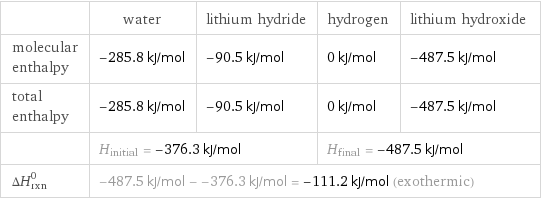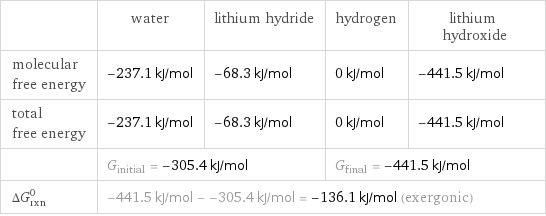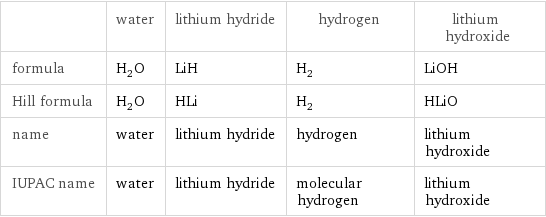Input interpretation

H_2O water + LiH lithium hydride ⟶ H_2 hydrogen + LiOH lithium hydroxide
Balanced equation

Balance the chemical equation algebraically: H_2O + LiH ⟶ H_2 + LiOH Add stoichiometric coefficients, c_i, to the reactants and products: c_1 H_2O + c_2 LiH ⟶ c_3 H_2 + c_4 LiOH Set the number of atoms in the reactants equal to the number of atoms in the products for H, O and Li: H: | 2 c_1 + c_2 = 2 c_3 + c_4 O: | c_1 = c_4 Li: | c_2 = c_4 Since the coefficients are relative quantities and underdetermined, choose a coefficient to set arbitrarily. To keep the coefficients small, the arbitrary value is ordinarily one. For instance, set c_1 = 1 and solve the system of equations for the remaining coefficients: c_1 = 1 c_2 = 1 c_3 = 1 c_4 = 1 Substitute the coefficients into the chemical reaction to obtain the balanced equation: Answer: | | H_2O + LiH ⟶ H_2 + LiOH
Structures

+ ⟶ +
Names

water + lithium hydride ⟶ hydrogen + lithium hydroxide
Reaction thermodynamics
Enthalpy

| water | lithium hydride | hydrogen | lithium hydroxide molecular enthalpy | -285.8 kJ/mol | -90.5 kJ/mol | 0 kJ/mol | -487.5 kJ/mol total enthalpy | -285.8 kJ/mol | -90.5 kJ/mol | 0 kJ/mol | -487.5 kJ/mol | H_initial = -376.3 kJ/mol | | H_final = -487.5 kJ/mol | ΔH_rxn^0 | -487.5 kJ/mol - -376.3 kJ/mol = -111.2 kJ/mol (exothermic) | | |
Gibbs free energy

| water | lithium hydride | hydrogen | lithium hydroxide molecular free energy | -237.1 kJ/mol | -68.3 kJ/mol | 0 kJ/mol | -441.5 kJ/mol total free energy | -237.1 kJ/mol | -68.3 kJ/mol | 0 kJ/mol | -441.5 kJ/mol | G_initial = -305.4 kJ/mol | | G_final = -441.5 kJ/mol | ΔG_rxn^0 | -441.5 kJ/mol - -305.4 kJ/mol = -136.1 kJ/mol (exergonic) | | |
Equilibrium constant
![Construct the equilibrium constant, K, expression for: H_2O + LiH ⟶ H_2 + LiOH Plan: • Balance the chemical equation. • Determine the stoichiometric numbers. • Assemble the activity expression for each chemical species. • Use the activity expressions to build the equilibrium constant expression. Write the balanced chemical equation: H_2O + LiH ⟶ H_2 + LiOH Assign stoichiometric numbers, ν_i, using the stoichiometric coefficients, c_i, from the balanced chemical equation in the following manner: ν_i = -c_i for reactants and ν_i = c_i for products: chemical species | c_i | ν_i H_2O | 1 | -1 LiH | 1 | -1 H_2 | 1 | 1 LiOH | 1 | 1 Assemble the activity expressions accounting for the state of matter and ν_i: chemical species | c_i | ν_i | activity expression H_2O | 1 | -1 | ([H2O])^(-1) LiH | 1 | -1 | ([LiH])^(-1) H_2 | 1 | 1 | [H2] LiOH | 1 | 1 | [LiOH] The equilibrium constant symbol in the concentration basis is: K_c Mulitply the activity expressions to arrive at the K_c expression: Answer: | | K_c = ([H2O])^(-1) ([LiH])^(-1) [H2] [LiOH] = ([H2] [LiOH])/([H2O] [LiH])](../image_source/ebccd6c866ea5eeec3130eea301d609e.png)
Construct the equilibrium constant, K, expression for: H_2O + LiH ⟶ H_2 + LiOH Plan: • Balance the chemical equation. • Determine the stoichiometric numbers. • Assemble the activity expression for each chemical species. • Use the activity expressions to build the equilibrium constant expression. Write the balanced chemical equation: H_2O + LiH ⟶ H_2 + LiOH Assign stoichiometric numbers, ν_i, using the stoichiometric coefficients, c_i, from the balanced chemical equation in the following manner: ν_i = -c_i for reactants and ν_i = c_i for products: chemical species | c_i | ν_i H_2O | 1 | -1 LiH | 1 | -1 H_2 | 1 | 1 LiOH | 1 | 1 Assemble the activity expressions accounting for the state of matter and ν_i: chemical species | c_i | ν_i | activity expression H_2O | 1 | -1 | ([H2O])^(-1) LiH | 1 | -1 | ([LiH])^(-1) H_2 | 1 | 1 | [H2] LiOH | 1 | 1 | [LiOH] The equilibrium constant symbol in the concentration basis is: K_c Mulitply the activity expressions to arrive at the K_c expression: Answer: | | K_c = ([H2O])^(-1) ([LiH])^(-1) [H2] [LiOH] = ([H2] [LiOH])/([H2O] [LiH])
Rate of reaction
![Construct the rate of reaction expression for: H_2O + LiH ⟶ H_2 + LiOH Plan: • Balance the chemical equation. • Determine the stoichiometric numbers. • Assemble the rate term for each chemical species. • Write the rate of reaction expression. Write the balanced chemical equation: H_2O + LiH ⟶ H_2 + LiOH Assign stoichiometric numbers, ν_i, using the stoichiometric coefficients, c_i, from the balanced chemical equation in the following manner: ν_i = -c_i for reactants and ν_i = c_i for products: chemical species | c_i | ν_i H_2O | 1 | -1 LiH | 1 | -1 H_2 | 1 | 1 LiOH | 1 | 1 The rate term for each chemical species, B_i, is 1/ν_i(Δ[B_i])/(Δt) where [B_i] is the amount concentration and t is time: chemical species | c_i | ν_i | rate term H_2O | 1 | -1 | -(Δ[H2O])/(Δt) LiH | 1 | -1 | -(Δ[LiH])/(Δt) H_2 | 1 | 1 | (Δ[H2])/(Δt) LiOH | 1 | 1 | (Δ[LiOH])/(Δt) (for infinitesimal rate of change, replace Δ with d) Set the rate terms equal to each other to arrive at the rate expression: Answer: | | rate = -(Δ[H2O])/(Δt) = -(Δ[LiH])/(Δt) = (Δ[H2])/(Δt) = (Δ[LiOH])/(Δt) (assuming constant volume and no accumulation of intermediates or side products)](../image_source/12d4d850c7a54b92571aaf5b6d02fb3a.png)
Construct the rate of reaction expression for: H_2O + LiH ⟶ H_2 + LiOH Plan: • Balance the chemical equation. • Determine the stoichiometric numbers. • Assemble the rate term for each chemical species. • Write the rate of reaction expression. Write the balanced chemical equation: H_2O + LiH ⟶ H_2 + LiOH Assign stoichiometric numbers, ν_i, using the stoichiometric coefficients, c_i, from the balanced chemical equation in the following manner: ν_i = -c_i for reactants and ν_i = c_i for products: chemical species | c_i | ν_i H_2O | 1 | -1 LiH | 1 | -1 H_2 | 1 | 1 LiOH | 1 | 1 The rate term for each chemical species, B_i, is 1/ν_i(Δ[B_i])/(Δt) where [B_i] is the amount concentration and t is time: chemical species | c_i | ν_i | rate term H_2O | 1 | -1 | -(Δ[H2O])/(Δt) LiH | 1 | -1 | -(Δ[LiH])/(Δt) H_2 | 1 | 1 | (Δ[H2])/(Δt) LiOH | 1 | 1 | (Δ[LiOH])/(Δt) (for infinitesimal rate of change, replace Δ with d) Set the rate terms equal to each other to arrive at the rate expression: Answer: | | rate = -(Δ[H2O])/(Δt) = -(Δ[LiH])/(Δt) = (Δ[H2])/(Δt) = (Δ[LiOH])/(Δt) (assuming constant volume and no accumulation of intermediates or side products)
Chemical names and formulas

| water | lithium hydride | hydrogen | lithium hydroxide formula | H_2O | LiH | H_2 | LiOH Hill formula | H_2O | HLi | H_2 | HLiO name | water | lithium hydride | hydrogen | lithium hydroxide IUPAC name | water | lithium hydride | molecular hydrogen | lithium hydroxide
Substance properties

| water | lithium hydride | hydrogen | lithium hydroxide molar mass | 18.015 g/mol | 7.95 g/mol | 2.016 g/mol | 23.95 g/mol phase | liquid (at STP) | solid (at STP) | gas (at STP) | solid (at STP) melting point | 0 °C | 680 °C | -259.2 °C | 462 °C boiling point | 99.9839 °C | | -252.8 °C | density | 1 g/cm^3 | 0.82 g/cm^3 | 8.99×10^-5 g/cm^3 (at 0 °C) | 1.46 g/cm^3 solubility in water | | reacts | | surface tension | 0.0728 N/m | | | dynamic viscosity | 8.9×10^-4 Pa s (at 25 °C) | | 8.9×10^-6 Pa s (at 25 °C) | odor | odorless | | odorless | odorless
Units
